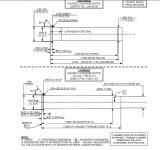The photos from earlier kind of sucked, so I took another with everything.
MagTech (CBC) 2.5" .410 shot shells, with box marked 36 ga.
Nitro cards.
Fiber cushion wads.
Over-shot cards.
And some trimmed pieces.
The process sounds complicated, but really isn't. There really aren't any actually reloading tools
required for the job, either. They just make it easier. ...As would using plastic shells, instead. (But, hey, nostalgia! And brass shells sound so much more awesome when ejected! PwufftIIiiiinnng!)
Cases are trimmed to rough length with a pipe cutter and a mandrel (27/64" drill rod) inserted inside the case. The mandrel keeps the case from collapsing with 'pizza cutter' style cutters, but cases can just as easily be cut with a hacksaw and a steady hand (don't snag it, it'll crease the case). I used the mandrel because I had it - I use that 27/64" (0.421"?) rod in the bores of .444 Marlin and .44 Magnum firearms for unrelated subjects.
Then they're trimmed to final length (2.000" for this chamber) on a lathe-style trimmer*, and chamfered and deburred.
*For this brass, I also had to massage the rims and bases a little bit with a drill and file, to fit the shell holder properly (for trimming and priming). But that isn't, necessarily, required. There are other ways to prime, and alternate methods for trimming, that don't require the use of a shell holder.
Large pistol primers are seated. A powder charge is loaded. A nitro card is pressed in. A cushion wad is inserted. The shot charge is poured. An over-shot card is seated. And, finally, I mark the type of shot and seal with nail polish. (Other sealants are better for repeaters, but I've found the nail polish to work just fine in single-shot or low recoil applications. Plus, it usually burns off completely.)
The better option here is using a crimp tool to crimp the load. ...But I don't have one, and crimping will shorten brass life.
Once fired, I clean the brass, knock the primers out with a punch and hammer (again - the shell holder helps, but isn't necessary), and reload without the trimming steps.
These specific markings:
4 is for number #4 shot.
R is for reclaimed shot. -Mostly #6 to #8, with the odd bit of #4 or #9 making an appearance. (Steel, rocks, and other unwelcome guests have been screened out.)
This wad column and powder charge allow a shot charge around 3/8 oz or less - or up to 7/16 oz with reclaimed shot (damaged shot packs tighter).


